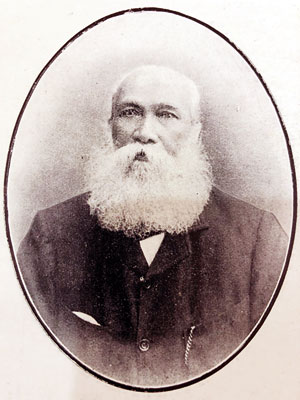Appreciations
 Remembering a great entrepreneur and philanthropist a century later
Remembering a great entrepreneur and philanthropist a century later
V. Jacob de Mel, the patriarch of a well-known family that dominated the business and agricultural landscape of Ceylon during colonial times died on April 1, 1919. His 100th death anniversary falls this year.
Jacob was the fifth son of Francisco De Mel and Telge Leonora Peiris. His family lineage can be traced back to 1534. The family is known to have held high office in the court of King Parakrama Bahu VI of Kotte. A student of S. Thomas’ College and Royal College, he was a Notary Public.
Jacob as has been written by his grandson Devar Surya Sena, “was a lovable old patriarch with a fine grey beard, his sparse hair combed back and tied in a small knot at the back. A curved tortoise shell comb like a crescent on his head in the fashion of the gentry of that time completed his “coiffure”. Wearing a tweed cloth and coat he drove a phaeton every Sunday to St Peter’s Church, Fort. He was a devout Christian and a true Sinhalese in his living and thinking”.
Jacob was a shrewd businessman whose family trading activities probably dated back to Dutch times, as mentioned in Kumari Jayawardena’s book, “From Nobodies to Somebodies”. He foresaw the potential of the plumbago industry and became a pioneer. He acquired the Ragedra mine in the Kurunegala district, which was the first mine in the East where explosives in mining for plumbago were used. (The mine was subsequently nationalised during the Sirima Bandaranaike Government.) A large Graphite rock is now on display at the American Museum of National History in New York.
By 1880 he owned one of the largest commercial houses employing a labour force of 3,000 in his mines, 2,500 on his estates and 500 at his stores in Colombo. Jacob invested in land on which he planted coconut, cinnamon, and tea. His grand-daughter Rohini de Mel says he planted over 4,000 acres of coconut. He also owned fibre mills at Madampe and Chilaw. The family along with other prominent Sinhala families of the time were market leaders in coconut ownership. He also invested in land in Cinnamon Gardens and his stores were at Lakeside and Alston Place, Hunupitiya.
H. L. De Mel & Company (Private) Ltd. was established by Jacob De Mel, in 1870, to manage his plantations, property and other operations. The company was named after his eldest son, Sir Henry Lawson De Mel and has been geared towards public service. Presently, the fourth and fifth generation is associated with the firm. Its headquarters, built in 1921 at De Mel building, Chatham Street, Fort has been documented as a heritage property.
An entrepreneur whose ‘business model’ was studied for years at the Colombo University, he rewarded those who served him by gifting them a house and five acres of land upon retirement. The stories passed amongst family members are of beggars lining up outside his house for a meal and his charity every Sunday. It was an era, which does not exist any longer, where entrepreneurship and charity went hand in hand without any thought of personal gain.
His marriage to Dona Helena Ferdinando, the daughter of Jeronis and Simona de Soysa produced nine daughters and five sons. He married his daughters to prominent men such as Sir James Peiris, the first Asian President of the Cambridge Union, who on his return was involved in the civic and political sphere; C.E. A. Dias, a prominent planter and philanthropist; Henry A. Peiris, on whose land Arpico and Hyde Park Residencies have been built, and Charles Peiris, a well-known notary, landowner and philanthropist.
“Villa de Mel” his home built in 1892 in Horton Place, Colombo 7 was one of the first homes in the area and is now listed as a heritage property.
Amongst some of his philanthropic acts were the funds he bestowed on the Victoria Memorial Eye Hospital and the De Mel Ward at the Lady Havelock Women’s Hospital. He served on the committee of the Victoria Home for Incurables. Jacob and his wife Helena created a Trust in their names for certain coconut properties which is managed by H. L. De Mel & Company (Private) Ltd.
The legacy of Jacob De Mel lives on in his descendants, many of whom have served the country he loved as politicians, lawyers, clergy, doctors, businessmen, musicians and teachers. Many have earned fame and continued his charity work. Despite his death a century ago, his legacy continues and has outlived his life span and in the words of Philip Carr Gomm
“The songs of our ancestors are also the songs of our children.”
His great grandchildren and
great great
grandchildren


